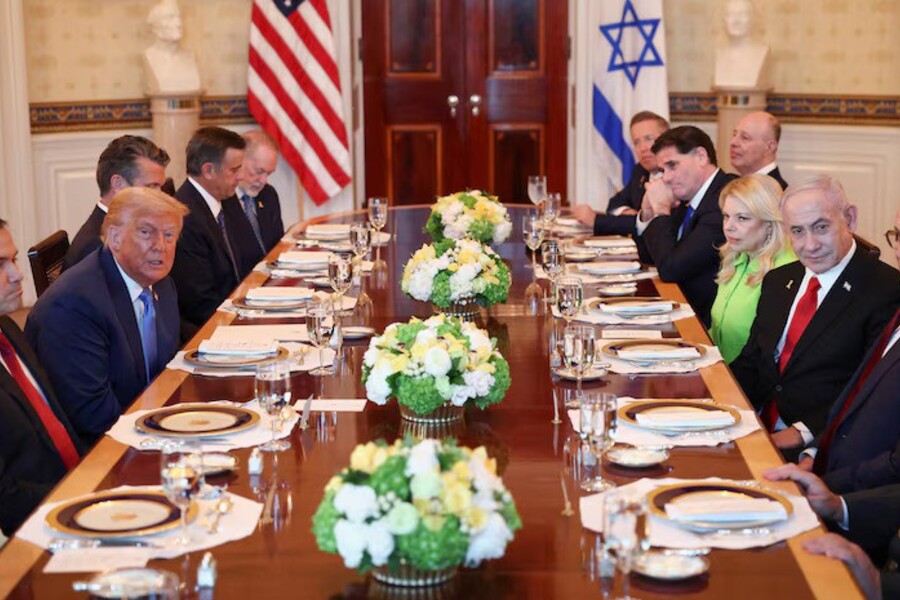As ceasefire talks between Israel and Hamas teeter at a critical juncture, former President Donald Trump has stepped into a leading diplomatic role, pressing Israeli Prime Minister Benjamin Netanyahu to agree to a truce in Gaza amid ongoing indirect negotiations in Doha. The high-stakes diplomacy comes as the Trump administration pursues a broader strategy to reshape Gaza’s future governance and reassert U.S. influence in the Middle East.
A Ceasefire Deal on the Table
The current deal, brokered with U.S. support, would bring a temporary 60-day halt to hostilities between Israel and Hamas. In exchange, ten Israeli hostages believed to be alive would be released, alongside the remains of 18 deceased detainees. These would be returned in five separate phases.
In return, Israel would commit to:
- A two-month ceasefire
- The release of an unspecified number of Palestinian prisoners
- Allowing a large-scale influx of humanitarian aid into Gaza
However, the exact mechanisms for distributing that aid remain a sticking point. Hamas has demanded that controversial entities such as the U.S.-backed Gaza Humanitarian Foundation (GHF) cease operations, favoring full control by the United Nations and other international organizations. U.S. officials say a compromise could involve a mixed model, as floated by Israel’s Ambassador to the U.N., Danny Danon, who mentioned a possible GHF-UN partnership for post-conflict aid distribution.
Major Sticking Points
Despite Israel’s agreement to the main tenets of the plan, Hamas remains hesitant. The core issue: Hamas wants firm assurances that the ceasefire will be a stepping stone toward a permanent end to the war — not just a pause in hostilities. This concern echoes the collapse of past negotiations.
Israel refuses to commit to any language that could constrain future military action, particularly as it remains resolute that Hamas must not play any governing role in Gaza’s future. Both Trump and Netanyahu are aligned on this point, viewing any potential arrangement akin to Hezbollah’s role in Lebanon — where a militant group holds de facto power — as unacceptable.
Additionally, the governance of Gaza after the ceasefire remains unresolved. Many regional stakeholders, including influential Arab states like Saudi Arabia, are pushing for the Palestinian Authority (PA) to assume control. However, Israel strongly opposes the PA’s involvement, given its concerns about political instability and past inefficiencies.
Diplomatic Maneuvering in Doha and Washington
Indirect proximity talks between Hamas and Israel continue in Doha, Qatar. Special Envoy for the Middle East Steve Witkoff has been dispatched to the region this week in a sign of growing U.S. commitment. Witkoff’s involvement is widely seen as a sign of intensified high-level diplomacy needed to close the gap.
Meanwhile, in Washington, Netanyahu’s meetings with Trump and senior officials like Secretary of State Marco Rubio have been described as “working engagements.” The Trump administration is not only focused on finalizing a ceasefire but also using the moment to define the long-term political and humanitarian strategy for the Gaza Strip — what is being referred to as the “day after” plan.
Trump’s Middle East Ambitions: A Grand Bargain?
Trump’s recent diplomatic overtures reflect his ambitions for a legacy-defining foreign policy win. Having long championed the Abraham Accords — the 2020 normalization agreements between Israel and several Arab nations — Trump is now seeking to expand that framework to include Gaza’s post-war future and potentially even diplomatic inroads with Iran.
According to Dana Stroul, former deputy assistant secretary of defense for the Middle East, Trump is looking for a “victory with a capital ‘V.’” After backing Israel during its military campaign in Iran, Trump has accumulated leverage with Netanyahu. Now, he’s pushing for that goodwill to translate into an end to the Gaza conflict.
“President Trump has put resources in the game, not just words,” Stroul said. “He has leverage at this moment in time to tell Netanyahu it’s time to wind down the wars in Gaza.”
There are also signs that Trump may attempt to tie progress in Gaza to diplomatic momentum on Iran. While the exact U.S. endgame in Iran remains unclear, officials suggest the administration may use this moment to define its strategy for containing Tehran and building regional consensus.
What’s Next?
For now, the pathway forward hinges on a delicate balance of interests:
- Hamas wants long-term assurances.
- Israel wants to preserve military flexibility.
- The U.S. seeks to mediate an end to the war — and chart a sustainable future for Gaza.
Negotiations continue in Doha, and Trump’s team is expected to keep up pressure on all sides. A ceasefire could be reached in the coming days — but without a broader agreement on post-war governance, aid distribution, and political authority in Gaza, any truce may be short-lived.
Takeaways for Readers
- What’s happening? Trump is urging Netanyahu to finalize a U.S.-brokered ceasefire deal with Hamas, which includes hostage exchanges, a 60-day truce, and humanitarian aid.
- Why does it matter? The deal could pause months of conflict and offer momentum toward a longer-term solution in Gaza — if unresolved issues can be bridged.
- What’s next? Talks continue in Doha. A ceasefire is possible, but major questions about Gaza’s governance and reconstruction still loom.
- What’s Trump’s role? He is positioning himself as a lead negotiator, tying the ceasefire effort into his broader Middle East agenda, including expansion of the Abraham Accords and containment of Iran.
This moment could be pivotal not just for Gaza’s future — but for the broader geopolitical balance in the Middle East.


